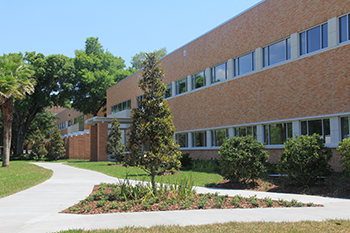Jacksonville Debuts New College of Health Sciences Building
 JACKSONVILLE, Fla. — A dedication of the new 30,000-square-foot College of Health Sciences (CHS) building at Jacksonville University was held on Sept. 4. The project is a major part of a larger, $20 million, phased plan to expand the college’s facilities, programs, equipment and faculty to meet growing demand.
JACKSONVILLE, Fla. — A dedication of the new 30,000-square-foot College of Health Sciences (CHS) building at Jacksonville University was held on Sept. 4. The project is a major part of a larger, $20 million, phased plan to expand the college’s facilities, programs, equipment and faculty to meet growing demand.
Dasher Hurst Architects served as the architect on the project, while Perry-McCall Construction Inc. was the general contractor. Both companies are locally based in Jacksonville. School Construction News spoke with Glenn Dasher, AIA, LEED AP BD+C, principal for the architecture firm, about what the new facility means for the university.
Q: What was the main goal on the project?
Dasher: The main goal of the project was to provide The College of Health Sciences with the additional space necessary to handle its continued growth and expanding programs. There are currently about 1,900 students in the College of Health Sciences. With Nursing, Speech-Language Pathology and Kinesiology program increases and new degrees, enrollment is projected to rise as much as 30 percent over the next several years.
A primary part of this puzzle was the development of a state-of-the-art Simulation Training and Applied Research (STAR) Center with 14 beds of newborn- to adult-patient mannequins, an Advanced Novel Equipment Workspace (NEW) speech pathology lab and a Physically Active Lifestyles (PAL) lab.
In addition to the School of Nursing, the CHS now includes the School of Applied Health Sciences (Department of Communication Sciences and Disorders; Department of Kinesiology) and the School of Orthodontics. The CHS has added a Bachelors of Science in Kinesiology, and its Masters of Science in Speech-Language Pathology (MS SLP) started this fall. In addition, the CHS is developing and planning to offer several new master’s degree programs that target critically needed areas such as health informatics (anticipated fall 2015). A Masters of Kinesiology and Athletics Training degree programs are also planned.
Q: What were some of the key design elements?
Dasher: The most important design element was the incorporation of a two-story linear atrium that runs the length of the building. It has clerestory windows that run along the top, bringing daylight to the interior offices and corridors and creating a number of positive attributes for the building. It creates a healthier interior environment while reducing the cost of interior lighting and power consumption. It also nourishes the indoor garden located on the first floor, which includes a cascading waterfall feature. The garden acts as a soft buffer from the adjacent corridor and the first floor office, while the surrounding seat wall provides casual areas for students to socialize.
Q: What were the biggest challenges, and how did project team overcome those challenges?
Dasher: The biggest challenge on the design side was created by the requirement that the new building exterior be a close mirror copy of the original Lazzara Health Sciences center building next door, while the interior was a completely new program and layout. All the required spaces and adjacencies were carefully organized to maximize every square foot available while still providing social spaces that were sacrificed in the older building.
For the construction side, the very limited site available and its immediacy to surrounding buildings and student circulation was a challenge. Because the exterior walls were all made of site cast structural concrete panels, finding enough to form and pour them was very challenging for the contractor. To solve the problem, they developed an intricate plan for pouring multiple panels on top of each other, which required a precise schedule and approach for lifting and putting the walls in place. It required extensive coordination and a very skilled superintendent.
Q: What about the project differs from ones you’ve completed in the past?
Dasher: This project cost came in significantly under the projected budget that was based on recently completed similar buildings. We have been under budget on other projects, but were almost 32 percent under, considering some of the nice design features and finishes that made it into the final product. We were very happy to be able to create such a nice new home for the faculty and students that speaks to their own specific mission and ideals.
